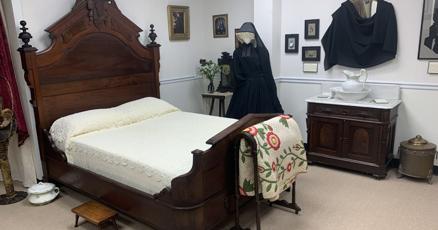
A new exhibit at the History Museum of Burke County features items that once belonged to a former North Carolina governor with a local connection.
Last fall, the museum received a set of Victorian-era bedroom furniture that belonged to NC Gov. Tod Caldwell from his great-great-grandchildren, Christine Kistler and her brother, Andrew Kistler III, according to museum curator Phyllis Wogan. The pieces include a bed, a gentleman’s dresser and a wash stand.
Caldwell (1818-74) was born and raised in Morganton as the son of a local merchant, according to his biography. He studied law and graduated from the University of North Carolina in 1840.
“In 1841, he began practicing law in Burke County, and in the same year, he won the first of many elections to public office, that of county prosecuting attorney,” the biography reads. “He never lost an election. His success as a criminal lawyer brought him a measure of fame in the mountain counties, which contributed to his election at age 24 to the state House of Commons.”
People are also reading…
He was elected to the state senate in 1850 and helped to found the Republican Party in NC in following the Civil War.
“In the new government required under the congressional plan of Reconstruction, Caldwell was elected lieutenant governor on the Republican ticket headed by William W. Holden,” his biography reads.
Holden was later impeached and removed from office, making Caldwell governor on March 22, 1871. Following an election, he was officially voted in as governor.
“Sadly, he died unexpectedly six months after being elected to his second term,” Wogan said. “He is buried in Morganton’s Forest Hill Cemetery.”
The museum had the furniture restored and installed it as part of an exhibit featuring 19th century mourning traditions.
“The room is very moody and full of historical information concerning burial and mourning,” Wogan said. “His bedroom furnishings fit the space beautifully, and because of his unexpected death, it enhances the somber mood of the time. Most people died at home and were laid out at home — there were no funeral parlors. Plus, it highlights Caldwell’s career during a very difficult period in history.”
She noted that Caldwell’s son, John, died at the Civil War Battle of Gettysburg on July 3, 1863 while fighting for the Confederate cause.
“He was 17 years old when he died,” Wogan said. “We have a transcription of the letter his commanding officer C.M. Avery sent to the Caldwells dated July 18, 1863, announcing his death. One quote stands out: ‘You may have the satisfaction to know that he fell where we could all wish to fall (if it be God will) with his face to the enemy.’ John was the only living son of Minerva and Tod Caldwell’s five children. His younger brother died in childhood. The whole family would have gone into full mourning at his death. He is also buried at Forest Hill Cemetery.”
She said people who lived during the 19th century often took their social cues from Queen Victoria.
“During the reign of Britain’s Queen Victoria, much of what she did was copied worldwide,” Wogan said. “What she wore was considered high fashion. When her beloved husband Prince Albert died, she and her family went into mourning, thereby setting the rules of how to dress, how to behave and how long to mourn.”
She encouraged people to visit the museum and learn more about this period in history.
“Our exhibit contains many, many examples of some traditions that remain today,” Wogan said. “Before embalming was common practice, flowers were brought to the home when paying respects for the family’s loss, not just as a gift, but to help cover the scent of a rotting corpse! Today, a grave blanket or floral tribute is no longer necessary, but a tradition from the past. There is no other museum in western North Carolina that handles this particular subject matter in such a thought-provoking way. You can stand in the middle of this display and get a real feeling of how things were when death was thought to be just as important as life itself.”
To learn more about the exhibit, contact the museum at 828-437-1777. Tours of the museum are free of charge. The History Museum of Burke County is located at 201 W. Meeting St., Morganton.

